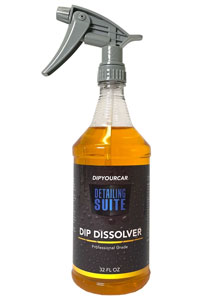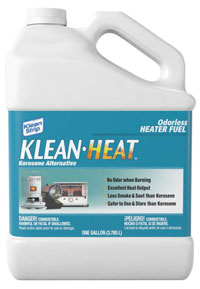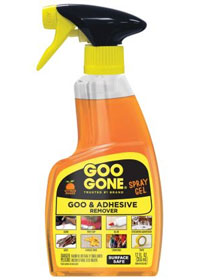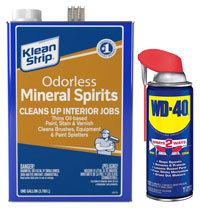Last Updated on November 16, 2021
As we already wrote about in our in-depth Plasti Dip guide, Plasti Dip is flexible, non-slip specialty rubber coating that comes in a huge variety of colors. It can be easily applied to tool handles, vehicles (wheels, painted surfaces, trim, badges, etc.), and many other creative uses via spraying, dipping, or brushing.
The beauty of Plasti Dip is that it’s removable so if you get tired of a certain color or you want to return the Plasti Dipped surface back to stock, you can do just that.
One of the more common uses of Plasti Dip is applying it to wheels. Because of the complex designs of some wheels or rims, removal of the product can be a bit trickier than a simple flat surface.
In an ideal situation, the Plasti Dip coating would be applied thick enough where simply peeling it all off by hand would be fairly quick and painless. However, that is usually not the case, especially with wheels.
In this article, we’ll go over four different methods to remove Plasti Dip from wheels where peeling it off in large chunks by hand simply isn’t possible.
Why Would You Want to Remove Plasti Dip?
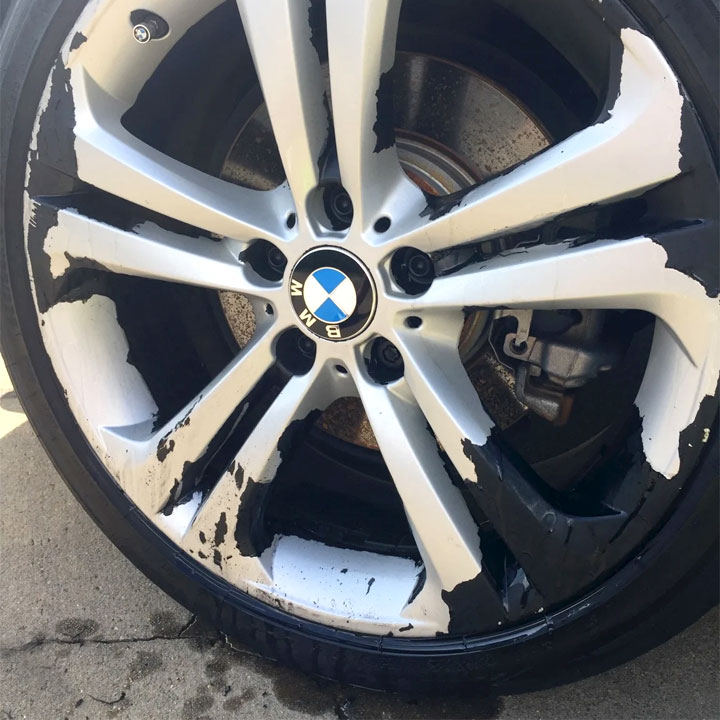
Plasti Dip (PD) is a durable attractive product when applied correctly to vehicles and/or their wheels. However there may be reasons why you might want to remove it. Some of the most common are:
- The PD coating is aging or damaged and is beginning to peel off in spots. Due to these conditions, it’s just not looking so good any more.
- You want to change the color of your car or wheels by applying new PD.
- You are prepping the car for resale and feel it will appeal to more buyers with a stock look.
- You have purchased this car with PD-coated wheels and now want to remove that treatment.
Whatever the reason, removing Plasti Dip can be a bit tedious, but it can be done. Let’s look at four ways you should consider that will work well for such a project.
See Also: Wheel Powder Coating (Frequently Asked Questions)
How to Remove Plasti Dip from Wheels
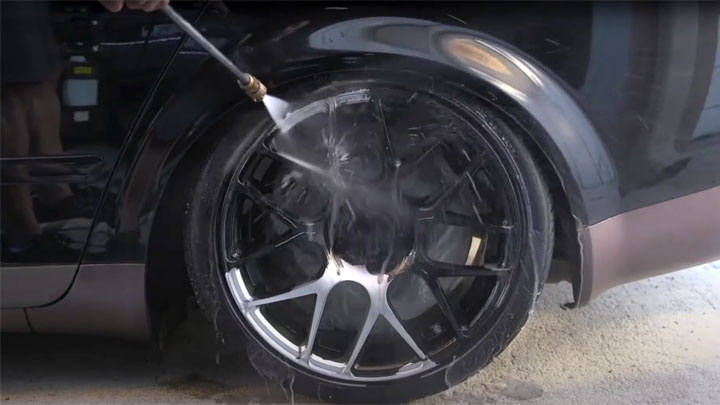
Prepping for Removal
Plan a Saturday morning or afternoon for this project. The various procedures below all use some kind of solvent. These solvents will be most effective if you choose a day when the outdoor temperatures are around 60 degrees F or higher.
The first step prior to attacking the wheels will be to take them off the car. Plasti Dip removal will be done one wheel at a time so you need not jack up the whole car. To safely raise your car, please review this article: 8 Auto Repair Safety Tips
Removing each wheel enables you to apply the PD dissolving chemicals to the wheels alone. Inadvertent application of these products to the brake calipers, rotors, brake hoses and suspension parts could damage these components. Why take that risk? Doing this job with wheels off the car eliminates this problem.
For each PD removal procedure below you should first wash each wheel with soap and water. Then thoroughly dry it. The presence of any water on a wheel will dilute or displace the solvent you use, possibly rendering it ineffective.
Also, cleaning solvents may irritate your hands. To protect them, put on a pair of nitrile mechanic's gloves during the cleaning process. Wearing safety glasses is also a good idea to protect your eyes when spraying these solvents.
When applying PD solvents to the wheels, avoid over-spraying the tires. A little overspray will be harmless but avoid soaking the tires with any of these solvents.
Additionally, you will want to perform the Plasti Dip removal process either in a very well-ventilated garage or outdoors. The dissolving chemicals may contain toxic and/or ill-smelling fumes that you won’t want to inhale. Also some of these chemicals pose a fire risk so absolutely no smoking or open flames should be permitted while doing this job.
Related: How to Debadge a Vehicle (Properly)
Following the removal of the PD coating, thoroughly wash each wheel again with soap and water to remove any solvent residue.
Now the Plasti Dip removal methods:
Method #1 – Dip Dissolver (Best for Removal of Thin Coats)
This method uses Plasti Dip’s own product called Dip Dissolver. Experience shows that properly applied Plasti Dip coatings will be thick and can be peeled off.
But some very thin treatments will not peel away. They will simply pull apart. If you have this problem, Dip Dissolver is for you.
Note: Dip Dissolver requires the use of a good pressure washer. If you don’t own one and have no desire to purchase one, a suitable washer can be rented at reasonable cost.
- With the wheel lying flat (or still attached to the vehicle), apply a generous spraying of Dip Dissolver to the wheel, wetting all coated surfaces.
- Allow the chemical to soak into the coating for about 5 minutes or until you can easily rub the coating off with a finger.
- Now use the pressure washer to rinse away the softened Plasti Dip. The video below shows exactly how this process can be done.
- If in some areas the PD does not come right off, dry those areas with a towel. Then reapply Dip Dissolver repeating the process above until the wheel is completely clean.
Method #2 – Kerosene (Fast and Cheap)
Typically used for heater fuel, kerosene is also works well as a cleaning agent and degreaser. Be sure to use a kerosene classified as low or no odor especially if working in your garage.
Items Required
- “Low odor” kerosene (like this one; typically marketed as heater fuel)
- 1″ wide (or so) paint brush
- Small container like a metal coffee can
- Small plastic-bladed scraper (or a small piece of scrap wood)
- Large piece of cardboard (to place on the ground under the wheel to soak up the kerosene for disposal)
Process
- Pour about 1 cup of kerosene into the open container.
- Using the paint brush, apply a generous amount, wetting all the coated surfaces of the wheel.
- Wait 10 minutes.
- Begin at any edge or corner of the wheel and push firmly with your scraper on the coating to break it free. Using your fingers or a pair of pliers (being careful to not scratch the wheel), grip the coating and peel off as much of it as possible. Repeat as needed to get all the coating off.
- In areas where the coating is really stubborn, apply kerosene again and repeat the process until all the Plasti Dip is completely removed.
Method #3 – Goo Gone (Slow Yet Safe)
Items Required
- Goo Gone (a 2-pack is most economical)
- Small plastic-bladed scraper (or a small piece of scrap wood)
- Roll of paper towels
Process
- Spray a light coating of Goo Gone on the entire wheel.
- Tear off one paper towel. Spray it with Goo Gone until soaked. Apply it to the wheel surface pressing it firmly to the wheel’s shape and into all the crevices.
- Repeat this process until all the coated surfaces are covered with paper towels saturated with Goo Gone. Small pieces of paper towel may be used to get the solvent into the lug nut recesses.
- Lightly spray the paper towels again with Goo Gone to make sure they are completely wet.
- Wait 5 to 10 minutes. Remove one of the paper towels.
- Begin the scraping process described in Method #2 above. If the Plasti Dip peels off, continue the process one paper towel at a time until all paper towels have been removed.
- If the PD does not peel off, replace the first paper towel and lightly respray the entire wheel with Goo Gone.
- Wait 5 minutes and repeat the scraping process above, removing one paper towel at a time. Small areas may need to be re-treated if the PD cannot be easily removed.
- To repeat this for subsequent wheels, discard the used paper towels and begin with clean ones.
Method #4 – WD-40 or Mineral Spirits (Goo Gone Alternatives)
Two other common chemicals can be used in place of Goo Gone using the same process as above. Mineral spirits (low odor variety) or WD-40 can be used. Each of them will soften the PD coating so it can be removed.
These options may not be as effective as the treatments described above but they should work nonetheless.
Finishing Up
Reinstall the wheels and tighten the lug nuts to the torque specification applicable for your car. See “Step #12 – Reinstall Wheels”, in this article for a brief discussion regarding torqueing the lug nuts.
When the job is complete, make absolutely certain you discard any waste, such as soggy paper towels and/or damp pieces of cardboard, in an environmentally friendly fashion.


